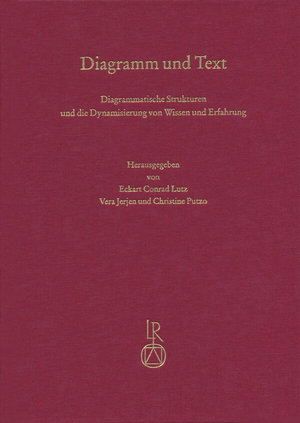
Diagramm und Text. Diagrammatische Strukturen und die Dynamisierung von Wissen und Erfahrung
Überstorfer Colloquium 2012
Diagramme, für die Isidors kosmologische rota als ‚bestes Beispiel‘ stehen kann, sind gerade aufgrund ihrer Abstraktionsleistung geeignet, auf die komplexe und in ihrer Komplexität letztlich weder begreifliche noch beschreibbare Welt so zu verweisen, dass sich Grundstrukturen ihrer Ordnung isolieren und daher graphisch anschaulich machen lassen und dass damit zugleich der ‚natürliche’ (naive) Blick auf die Welt einem neuen, bewussten weicht: das Diagramm regt an, bestimmte Merkmale der abstrakt geschauten Ordnung im natürlichen Erscheinungsbild der Welt analytisch wahrzunehmen, sie darin ‚wiederzuerkennen’ und so die Welt auf bestimmte Aspekte ihrer Ordnung hin zu ‚durchschauen‘. Und das Diagramm erlaubt zugleich zu verstehen, dass die ‚künstliche‘ (gelehrte) Abstraktionsleistung ihren Zweck erst erfüllt, wenn man die Spannung zwischen Abstraktion und nicht hintergehbarer Unergründlichkeit der Welt als Schöpfung akzeptiert und sich auf die erkenntnisstiftende gedankliche Bewegung zwischen beiden einlässt. Ziel der intendierten Erkenntnisprozesse ist dabei eine Zusammenschau (contuitus) unter denjenigen Aspekten, die zunächst abstrahierend herausgelöst wurden. Die in Diagrammen dieser Art aufscheinenden Strukturen geben zugleich Einblick in das Wesen ihres Urhebers, sind Medien der Gotteserkenntnis.
Die Fragestellung des Colloquiums, dessen Erträge hier vorliegen, war eine genuin literarhistorische. Allerdings sollte das zentrale Interesse an der (in weiterem Sinn) literarischen Vermittlung gelehrten Wissens im höfischen Kontext erweitert werden durch die Einbeziehung analoger Phänomene in anderen Zusammenhängen, um die Beschreibung anderer Erscheinungsbilder diagrammatischen Denkens wie um dessen theoretische Reflexion. Das Spektrum der Beiträge reicht von der diagrammatischen Hinterlassenschaft der Antike bis zu verschiedenen Formen eines definitorisch zunächst offen zu haltenden, diagrammnahen oder eben diagrammatischen Denkens, das sich unter anderem in den Spielarten des Meditierens, des fiktionalen Erzählens, des historiographischen Schreibens oder des Spielens konkreter fassen lässt. Alle Erscheinungsformen des Diagrammatischen, von den einfachsten bis zu den komplexesten, von der konkret anschaulichen rota Isidors bis zu abstrakten, nur gedachten Text- und Bildstrukturen verbinden mit grosser Regelmässigkeit Effekte des Konstatierens, der Kristallisation mit solchen der Freigabe, der Dynamisierung, sind immer epistemisch relevant und bieten den Rezipienten die Möglichkeit, Wissensstände zu erweitern, Einsichten zu gewinnen und eigene Haltungen wie eigenes Handeln zu revidieren.
Diagrams, of which Isidore’s cosmological rota is perhaps the best example, are marked by their potential for abstraction. This same potential means that they lend themselves to a distinctive way of referring to a world that is complex and, in its complexity, ultimately defies comprehension and description. Diagrams allow basic structures of its order to be isolated and thus made graphically perceptible, with the ‘natural’ (naïve) view of the world giving way to a new, self-aware one in the process. The diagram is a cue to appreciate analytically certain features of an order that has been abstractly discerned in the natural form of the world, to recognize those features ‘again’ in it, and thus to ‘see through’ the world in distinguishing particular aspects of the order behind it. The diagram at the same time makes it possible to grasp the fact that the ‘artificial’ (scholarly) accomplishment of abstracting serves its purpose only if the tension between abstraction and the fundamental unfathomability of the world as creation is accepted, and the intellectual motion between the two that leads to comprehension is embraced. The aim of the intended processes of comprehension here is a view (contuitus) that brings together those aspects that were initially singled out in the course of abstraction. The structures that appear in diagrams of this kind also give a glimpse of their maker’s nature , are media for knowing God.
The theme of the colloquium whose findings are presented here was directly grounded in literary history: the central interest lay in the literary (in a broad sense) mediation of scholarly knowledge in a courtly context. The aim, however, was also to extend this interest by including analogous material from other contexts, so as to cover both the description of other forms in which diagrammatic thought manifests itself and theoretical reflection on it. The scope of the contributions ranges from the diagrammatic legacy of Antiquity to various forms of a way of thinking – the definition of which is kept open here – that has an affinity with diagrams or is, quite simply, diagrammatic. The varieties of it that can be encountered more tangibly include, among others, meditation, fictional narration, historiographical writing, or play. The forms in which the diagrammatic manifests itself range from the physically visible rota of Isidore to abstract structures of text and image that exist only in thought. They all, from the most simple to the most complex, show great consistency in combining instances of conclusion, of stabilization, with instances of release, of catalysis; are always epistemically relevant; and offer recipients the chance to expand their knowledge, gain new insights, and reassess their own attitudes and actions.






